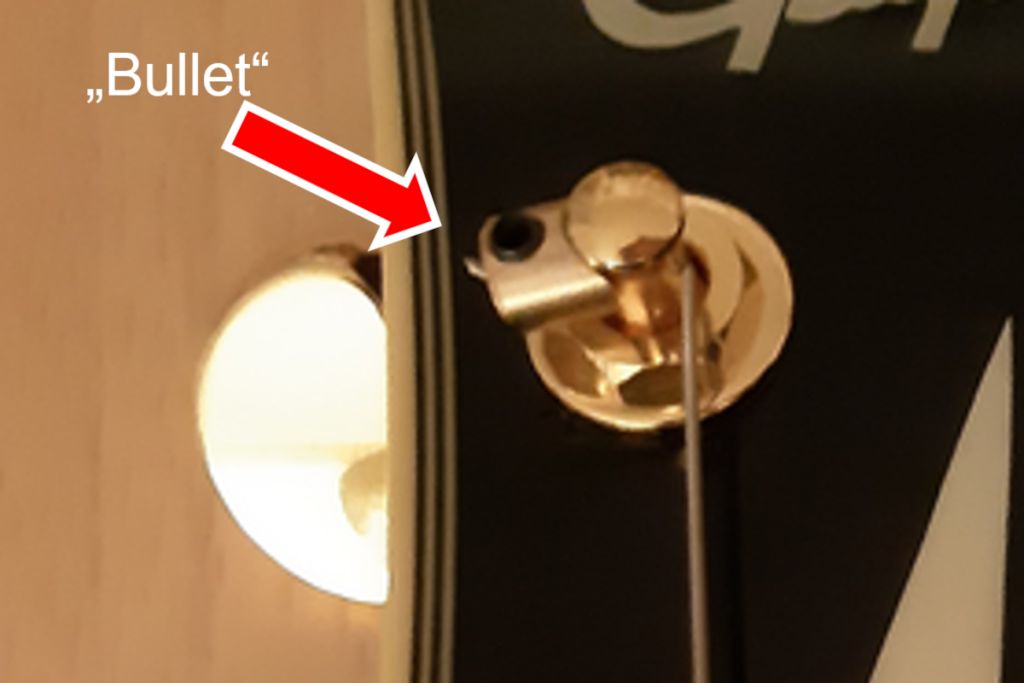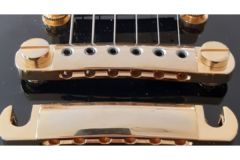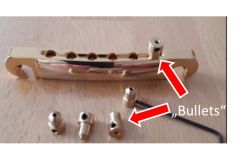String locks - effective clamping mechanisms for stringed instruments

The tuning stability of stringed instruments - e.g. guitars - depends, among other things, on the fixation of the two string ends. The underlying invention optimizes this by using small clamping components ("bullets") whose use does not require any modification measures and is always reversible.
These clamping components thus lead to increased tuning stability in stringed instruments and at the same time to less (time-) consuming string changes. The bullets are used either on the machine head or on the bridge.
One of the factors affecting the tuning stability of stringed instruments, such as electric or acoustic guitars, is the fastening of the two ends of the strings. This fastening process can be optimized with high-quality components both on the tuners and on the bridge. To this end, dedicated devices such as locking tuners are used, providing an integrated clamping mechanism that facilitates string winding.
Solution
For non-serially equipped instruments, retrofitting is expensive and sometimes involves irreversible conversion processes requiring a specialist’s work; it may be undesirable as it compromises the original status of the instrument (a valuable collector’s item, for instance). The invention presented herein involves small clamping components called bullets that require no conversion, the process is fully reversible at any time.
Advantages
- Affordable, simple complement to lock strings
- No instrument conversion work necessary
- Can be used flexibly – on the tuners, bridge, or tailpiece
Scope of application
These clamping components significantly enhance tuning stability for all stringed instruments while reducing the time required for the (re-)stringing as follows:
- On the tuners (usually at the headstock): After the string is fed through the hole in the tuner peg itself, it is passed through the clamping component (“bullet”), where it is clamped and fastened with a built-in screw using an Allen wrench. The string tension created upon tuning of the string provides an intimate connection between the bullet and the tuner peg (see Fig. 1).
- On the bridge or tailpiece (usually on the body): The clamping component is pressed onto the string, which has already passed through the bridge or tailpiece (stop-tailpiece, for instance) and is clamped analogously to 1) (see Fig. 2).
- The bridge or tailpiece can be entirely replaced with an integrated array of screws that engage the strings perpendicularly (see Fig. 3).
The use on bridges and tailpieces is not limited to Les-Paul®-style like stop-tailpieces. Telecaster®- or Stratocaster®- like instruments and other stringed instruments besides electric guitars can benefit from it as well. Variants 2) and 3) use the standard ball-ends provided with the strings to fasten them on the tuners.
Cooperation
All three components listed were adapted for use with various guitars and tested successfully. On behalf of University of Münster, we extend the invitation to acquire commercial licenses. A patent is pending for this invention.
Region
Europe, America, Asia
Contact
Provider contact:
Petr Hamrozi
ProfiBusiness.eu
Mobil phone: +420 733 139 882 (CZ), +421 915 946 533 (SK)
E-mail: info@profibusiness.eu
Www: www.profibusiness.eu
Date of entry
January 15, 2024
Fotogalerie
Translator
ProfiBusiness.world
Business Platform
Acquisitions
Business cooperation, export and import
Companies for sale
Corporate financing and loans
Export and import
Investments
Projects, ideas and patents for sale
Real estate for sale
Technologies, machines and production equipment
Vacant capacity
Present your aim on ProfiBusiness.world
Advertising order
Selected fields
Agriculture
Animals and pet supplies
Automotive
Banking and insurance
Boats and shipping industry
Building and architecture
Business
Education
Electrical industry
Electronics
Engineering
Environment
Finance, taxes and accounting
Flowers and plants
Food and beverage industry
For companies
Forestry and wood processing
Furniture
Gastronomy and hotel industry
Glass, ceramics and porcelain
Healthcare and pharmacy
Hobby and garden
Home and household goods
HR
Hygiene, drugstore and cosmetics
Charity and social responsibility
Chemical
Institution
IT and computers
Law and legislation
Management and certification systems
Minerals
Office
Packaging and packaging technologies
Paper industry
Plastic and rubber industry
Power engineering
PR and marketing
Printing and printing technology
Railway industry
Real estate
Safety, security and protection
Science and research
Social services
Sport and relax
Steel and iron processing
Telecommunications and the internet
Textile and leather industry
Tourism
Toys, games and entertainment
Transport and logistics





